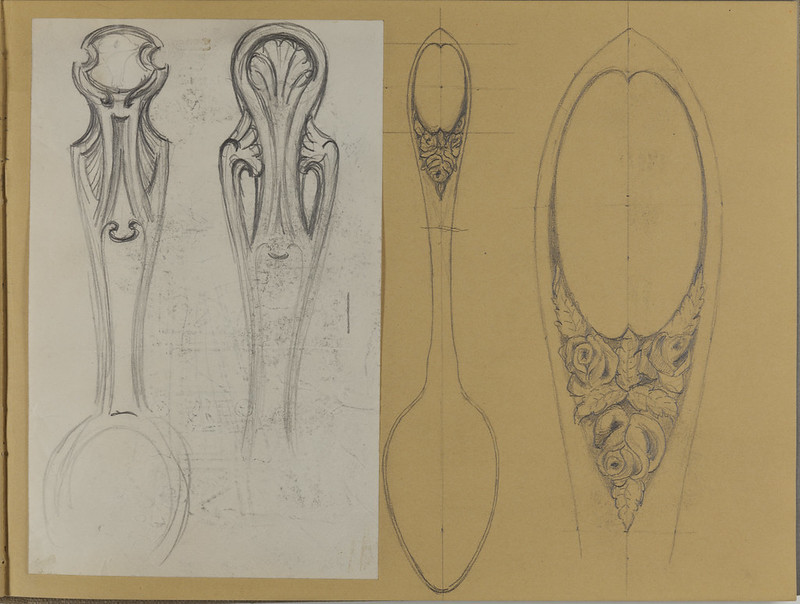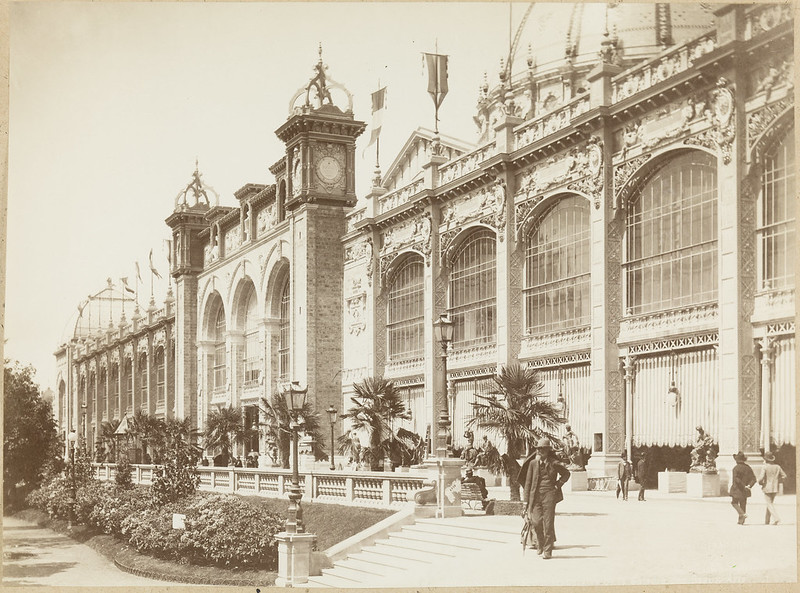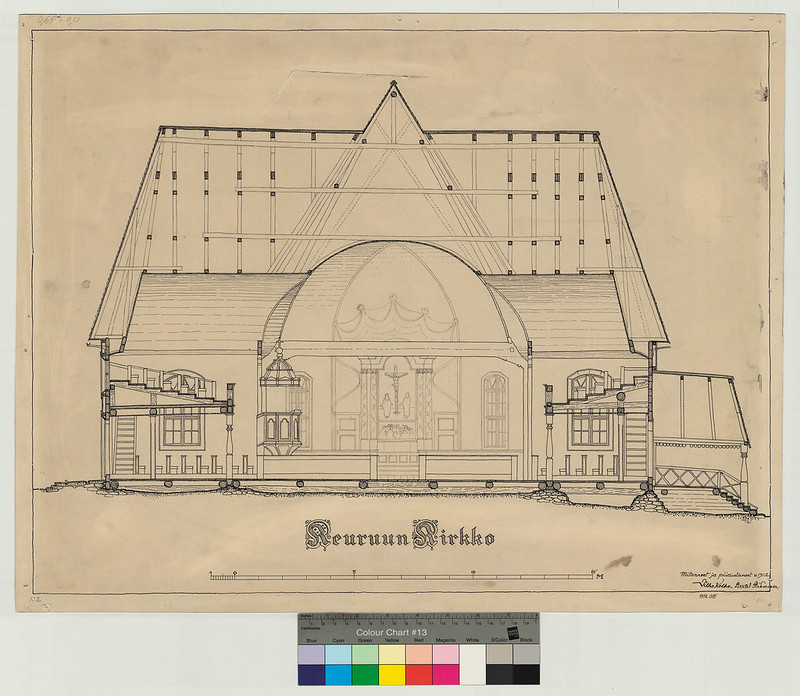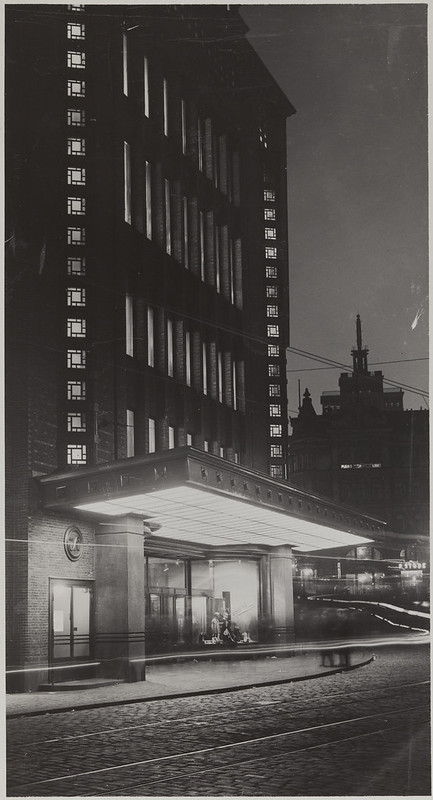Aalto University Archives
- Web: https://www.aalto.fi/en/archives
- Wikidata:
- Wikimedia Commons:
- Contact: Tove Ørsted, tove.orsted[a]aalto.fi
- About: Historic photographs, drawings and teaching resources documenting art, architecture, design and technology education and student life from late 19th century onwards. Historic teaching resources include an image set from The Paris World Exhibition 1889 and drawings by notable teachers including architect Gustaf Nyström and sculptor Johann Friedl.
aalto.finna.fi
Johann Friedl
Friedl, Josef Johann Emerich s.16.5.1863 Hohenstadt, Itävalta k. 9.1.1937; Opettaja Taideteollisuuskeskuskoulun veisto-osastolla 1890-1937
![]()
Paris World Exhibition 1889
Measurement Drawings
Aalto University’s and its predecessor University of Technology’s architecture teaching has for over hundred years included the tradition of measurement drawing. From 1907 to 2014 it was compulsory to prepare a measurement drawing of a significant building as part of an architect’s education.
A collection of thousands of drawings now belong to the Aalto University Archive collection offering an important archive for researchers. In early decades of 1900 drawings were made of medieval churches, later there has been concentration on wooden architecture.
In this album we are presenting all drawings from 1907 to 1919 in high resolution.
![]()
Architecture photography
Ajapaik
- Web: ajapaik.ee
- Wikidata: Q28845848
- Wikimedia Commons: Ajapaik
- Contact:
- About:
Ajapaik
![]()
(data), Creative Commons licenses (photos), MIT licence (code)
Ajapaik Android app
![]()
(data), Creative Commons licenses (photos), MIT licence (code)
The Finnish Heritage Agency
- Web: www.museovirasto.fi
- Wikidata: Q3029524
- Wikimedia Commons: Finnish Heritage Agency
- Contact: Hannu Häkkinen hannu.hakkinen@museovirasto.fi, Suvi Sillanpää suvi.sillanpaa@museovirasto.fi
- About: The Picture Collections of the Finnish Heritage Agency records and tells stories of the history and cultures of the area of Finland, the built environment, and the Finno-Ugric cultures, as well as the cultures of areas outside Finland through documentation by Finnish researchers and explorers. The material in the collections covers historical events as well as depictions of the everyday lives of the people. The collections also include the extensive collections of the Press Photo Archive (JOKA), which include news and entertainment images from newspapers over the past decades. The pictures (created with different techniques (photographs, drawings, watercolours, graphics, and prints) date from the 1500s to the present.
The Picture Collections – Museoviraston Kuvakokoelmat

![]()
with some minor exceptions
The Finnish Civil War 1918

Images from The Finnish Civil War 1918. The dataset (digitised sample from the collection) consist of over 2,300 images from the time of Finnish Civil war 1918 from various locations in Finland and representing the different perspectives to the events.
Public Gatherings - Demonstrations and Celebrations

The Picture Collections include photographs from demonstrations from 1905 to date, rock festivals, folk festivals, annual festivals, markets and local events that bring people together, but often also make visible the differences between them.
![]()
with some minor exceptions
Everyday Life through the Decades 1900-
Food, fashion, technology, politics, 1960’s, 1970’s and other thematic albums (679 pictures) that present people’s lives through the the decades of the 1900’s.
![]()
CC-BY-NC-SA 2.0 or CC-BY-NC-ND 2-0 (to be checked from each photo)
The Finnish Maritime Museum
- Web: www.kansallismuseo.fi/en/maritime-museum
- Wikidata: Q971755
- Wikimedia Commons: Maritime Museum of Finland
- Contact:
- About: Valokuvia merimuseon kuvakokoelmien FÅA-Silja Line alakokoelmasta
The Picture Collections – Museoviraston Kuvakokoelmat
![]()
CC BY 2.0
The Finnish Museum of Photography
- Web: www.valokuvataiteenmuseo.fi
- Wikidata: Q11895148
- Wikimedia Commons: Finnish Museum of Photography
- Contact: Laura Gelmi, curator of collections, laura.gelmi(at)fmp.fi, tel. 050 347 1475 Anni Wallenius, chief curator of collections, anni.wallenius(at)fmp.fi, tel. 041 440 6387
- About: Nearly 600 photographs from the Museum’s collections available on museum’s Flickr account.
The Finnish Tourism Association’s collection
The collection of Central Union of Consumer Co-operatives (KK) feature images of urbanisation, industrialisation and the emergence of consumer culture. The vantage point is that of the working class. We see work and workers move from villages to cities, from fields to assembly lines.
![]()
The collection of Central Union of Consumer Co-operatives (KK)
The collection of Central Union of Consumer Co-operatives (KK) feature images of urbanisation, industrialisation and the emergence of consumer culture. The vantage point is that of the working class. We see work and workers move from villages to cities, from fields to assembly lines.
![]()
Helsinki street views in early summer mornings, photographed by I.K. Inha in 1908-1909.
I. K. Inha: Finnish Agriculture / Suomen maatalous
Finnish agriculture photographed by I.K. Inha in 1899 as a commission for the World’s Fair (Exposition Universelle) in Paris in 1900. Including individual portraits of cows and bulls posing next to their owners.
![]()
Salon Strindberg & Atelier Universal: Finnish artist portraits / Suomalaisia taiteilijamuotokuvia
The art gallery Salon Strindberg (1898–1992) in Helsinki was known for its exhibitions of Finnish and international visual art. In addition, artist materials and tools, frames, artesanal products and printed images were sold there.
The gallery also made a popular post card series featuring studio portraits of the Finnish cultural elite in the early 20th century. The photographic portraits were made by the Atelier Universal, directed by the German-born photographer Carl Klein. 50 glass negatives of those portraits exist in the collections of the Finnish Museum of Photography.
Helsinkiläinen taidegalleria Salon Strindberg (1898–1992) esitteli ja möi ajankohtaista suomalaista ja kansainvälistä kuvataidetta. Lisäksi yrityksellä oli myynnissä mm. kehyksiä, taiteilijatarvikkeita ja taideteollisuustuotteita sekä painokuvia.
Salon Strindberg tuotti myös suosittuja ateljeemuotokuvia 1900-luvun alun taiteilijoista. Kuvia myytiin postikortteina. Kuvissa esiintyy itsenäistyvän Suomen kuvataiteen, kirjallisuuden, teatterin ja musiikin merkkihenkilöitä.
Muotokuvat ovat saksalaissyntyisen valokuvaajan Carl Kleinin johtaman helsinkiläisen Atelier Universalin käsialaa. Suomen valokuvataiteen museon kokoelmissa on noin 50 näiden muotokuvien alkuperäistä lasinegatiivia, joista nämä kuvat on digitoitu.
![]()
Daguerreotypes
The daguerreotype process was the earliest functioning photographic method. It was developed by two Frenchmen: Joseph Nicéphore Niépce and Luis Jacques Mandé Daguerre.
In Finland, the first daguerreotype was seen in Turku in 1840. The first daguerreotype made in Finland was a street view from Turku, made by Dr. Henrik Cajander in 1842. It is preserved in the collections of the Museum Centre of Turku. The daguerreotypes seen here belong to the collections of the Finnish Museum of Photography and are also included in the international Daguerreobase project: www.daguerreobase.org
![]()
Autochrome
Autochrome was the first commercially successful colour photography process. It was developed by the French brothers Auguste and Louis Lumière. The technique was patented in 1903 and launched on the market in 1907.
Photographers:
Reino Pietinen (1891–1921) was an amateur photographer who got his first camera at the age of 20 in Lausanne in Switzerland, where he had travelled to get treatment for his poor health. All Reino Pietinen’s three brothers also took up photography, and two of them, Aarne and Viljo, later became professional photographers. A great family of photographers, also dubbed the “Pietinen clan”; was born.
Maximilian Othmar Neuscheller (1862–1919) was a Swiss-born rubber manufacturer and amateur photographer, based in St. Petersburg, whose family had a summer residence, the Suur-Merijoki manor, in the Karelian Isthmus, from 1900. Neuscheller, who was into technology, took stereoscopic Autochromes.
![]()
Levas: Jean Sibelius & Ainola
Photos of Jean Sibelius and his surroundings in Ainola
![]()














